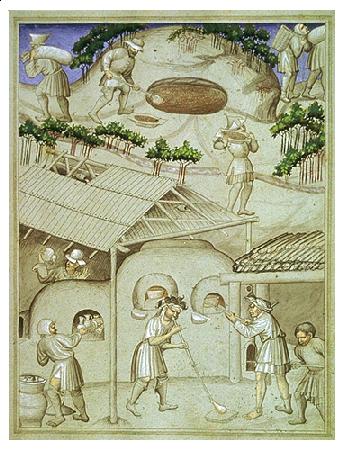Storia del vetro di Murano
I fondenti dei vetrai muranesi. IV parte: ceneri potassiche e sodiche (più o meno buone) nel SettecentoThe fluxing agents of Muranese glassmakers. Part 4: Potash and soda ashes in the 18th century

Nel Settecento i vetrai muranesi usarono come fondente, nelle produzioni più pregiate, il nitrato di potassio e tentarono (con risultati meno felici) di introdurre il carbonato di potassio, ricavandolo dalle ceneri di legna ("cenere ordinaria dei nostri focolari", scriveva Briati), come facevano in Germania.
Il fondente più adoperato a Murano, tra la seconda metà del Settecento e quella dell'Ottocento fu la "cenere di Sicilia".
Il suo costo e le difficoltà di approvvigionamento spinse però i muranesi ad usare materiali locali, spesso di qualità scadente.
Usarono cenere delle fornaci di mattoni nella produzione di lastre, la principale attività nell'isola nel Settecento. Non veniva depurata e le lastre riuscivano opache, piene di bolle e poco resistenti.
La Repubblica sostenne la coltivazione dei "roscani", piante lagunari e costiere da cui si poteva ricavare una cenere di qualità non costante, ma il suo utilizzo restò limitato alle produzioni vetrarie meno pregiate.

In the eighteenth century, Muranese glassmakers used potassium nitrate as a flux for high-quality glass and they tried to introduce potassium carbonate (with not as good results), which they obtained from
wood like german glassmakers. The "ash from Sicily" was the main flux used in Murano between in the second half of the 18th up to the end of the 19th centuries. Yet, its costs and the difficulties of supply induced the
glassmakers to use local raw materials, often of poor quality. They used brickklin ash for sheet glass manifacturing, the main activity on the island in the 18th century.
It was not purified and the sheets were opaque, with plenty of bubbles and a low resistance. The Venetian Republic supported the cultivation of "roscani", a kind of coastal and lagoon plants from which ash of varying quality could be prepared,
but it was used only for common glass products



Paolo Zecchin Via Cappuccina 13 Mestre Venezia
The fluxing agents of Muranese glassmakers. Part 4: Potash and soda ashes in the 18th century

Nel Settecento i vetrai muranesi usarono come fondente, nelle produzioni più pregiate, il nitrato di potassio e tentarono (con risultati meno felici) di introdurre il carbonato di potassio, ricavandolo dalle ceneri di legna ("cenere ordinaria dei nostri focolari", scriveva Briati), come facevano in Germania.
Il fondente più adoperato a Murano, tra la seconda metà del Settecento e quella dell'Ottocento fu la "cenere di Sicilia".
Il suo costo e le difficoltà di approvvigionamento spinse però i muranesi ad usare materiali locali, spesso di qualità scadente.
Usarono cenere delle fornaci di mattoni nella produzione di lastre, la principale attività nell'isola nel Settecento. Non veniva depurata e le lastre riuscivano opache, piene di bolle e poco resistenti.
La Repubblica sostenne la coltivazione dei "roscani", piante lagunari e costiere da cui si poteva ricavare una cenere di qualità non costante, ma il suo utilizzo restò limitato alle produzioni vetrarie meno pregiate.

In the eighteenth century, Muranese glassmakers used potassium nitrate as a flux for high-quality glass and they tried to introduce potassium carbonate (with not as good results), which they obtained from
wood like german glassmakers. The "ash from Sicily" was the main flux used in Murano between in the second half of the 18th up to the end of the 19th centuries. Yet, its costs and the difficulties of supply induced the
glassmakers to use local raw materials, often of poor quality. They used brickklin ash for sheet glass manifacturing, the main activity on the island in the 18th century.
It was not purified and the sheets were opaque, with plenty of bubbles and a low resistance. The Venetian Republic supported the cultivation of "roscani", a kind of coastal and lagoon plants from which ash of varying quality could be prepared,
but it was used only for common glass products



Paolo Zecchin Via Cappuccina 13 Mestre Venezia
In the eighteenth century, Muranese glassmakers used potassium nitrate as a flux for high-quality glass and they tried to introduce potassium carbonate (with not as good results), which they obtained from wood like german glassmakers. The "ash from Sicily" was the main flux used in Murano between in the second half of the 18th up to the end of the 19th centuries. Yet, its costs and the difficulties of supply induced the glassmakers to use local raw materials, often of poor quality. They used brickklin ash for sheet glass manifacturing, the main activity on the island in the 18th century. It was not purified and the sheets were opaque, with plenty of bubbles and a low resistance. The Venetian Republic supported the cultivation of "roscani", a kind of coastal and lagoon plants from which ash of varying quality could be prepared, but it was used only for common glass products
